Report: Managing People in Organizations - Recruitment & Motivation
VerifiedAdded on 2023/06/10
|8
|1738
|358
Report
AI Summary
This report delves into the critical aspects of managing people within an organizational context. It begins by outlining the recruitment and selection process, detailing the steps involved in identifying and hiring suitable candidates. The report then explores the importance of employee induction and training, emphasizing their roles in integrating new hires and enhancing existing employees' skills and knowledge. Furthermore, it examines two prominent motivational theories: Maslow's Hierarchy of Needs and Herzberg's Two-Factor Theory, discussing their applications in fostering employee motivation and job satisfaction. The report also analyzes the factors that influence individual behavior at work, including leadership, work environment, communication, and self-perception, highlighting their impact on employee performance and organizational success. Finally, the report concludes by summarizing the key findings and emphasizing the significance of effective people management practices in achieving organizational goals and fostering a productive work environment.
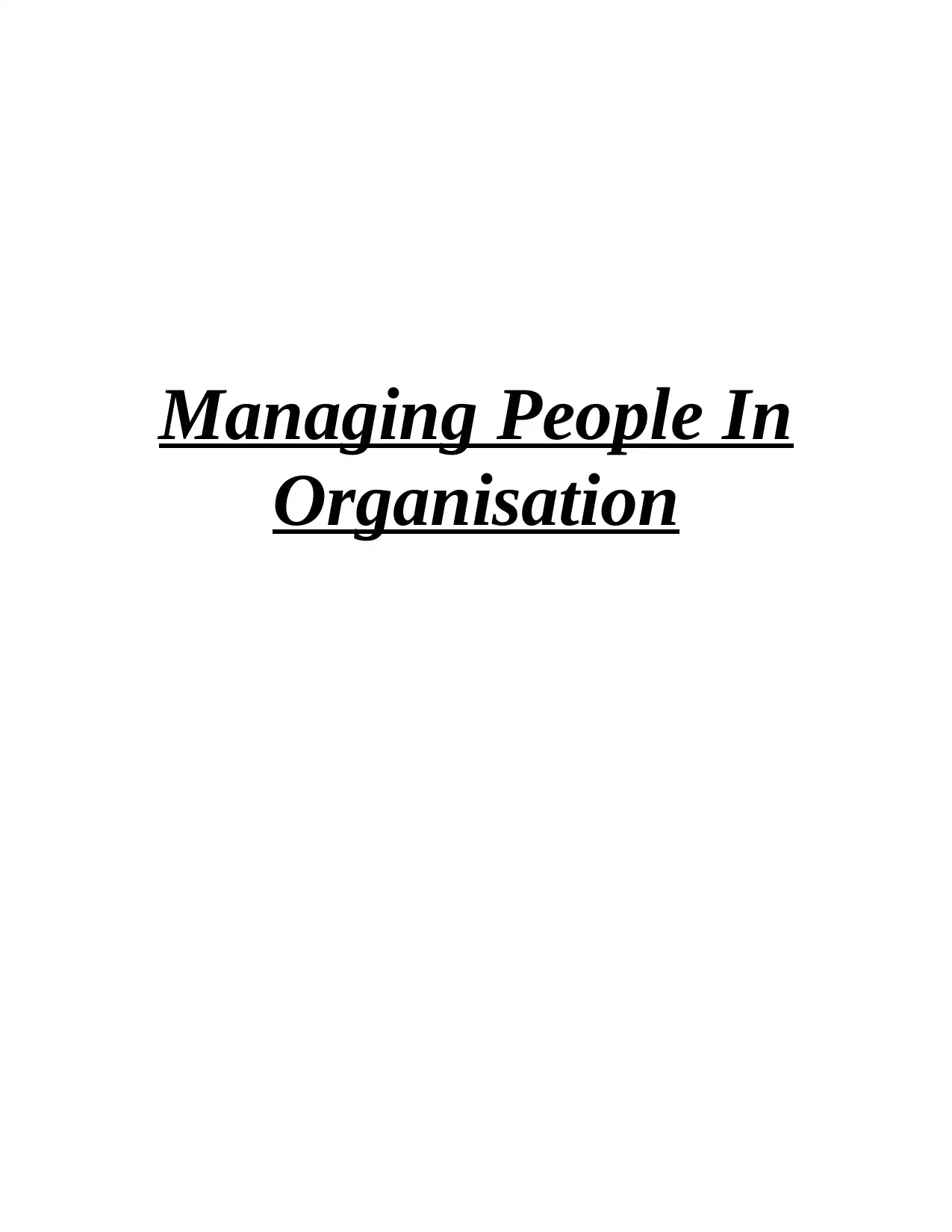
Managing People In
Organisation
Organisation
Paraphrase This Document
Need a fresh take? Get an instant paraphrase of this document with our AI Paraphraser
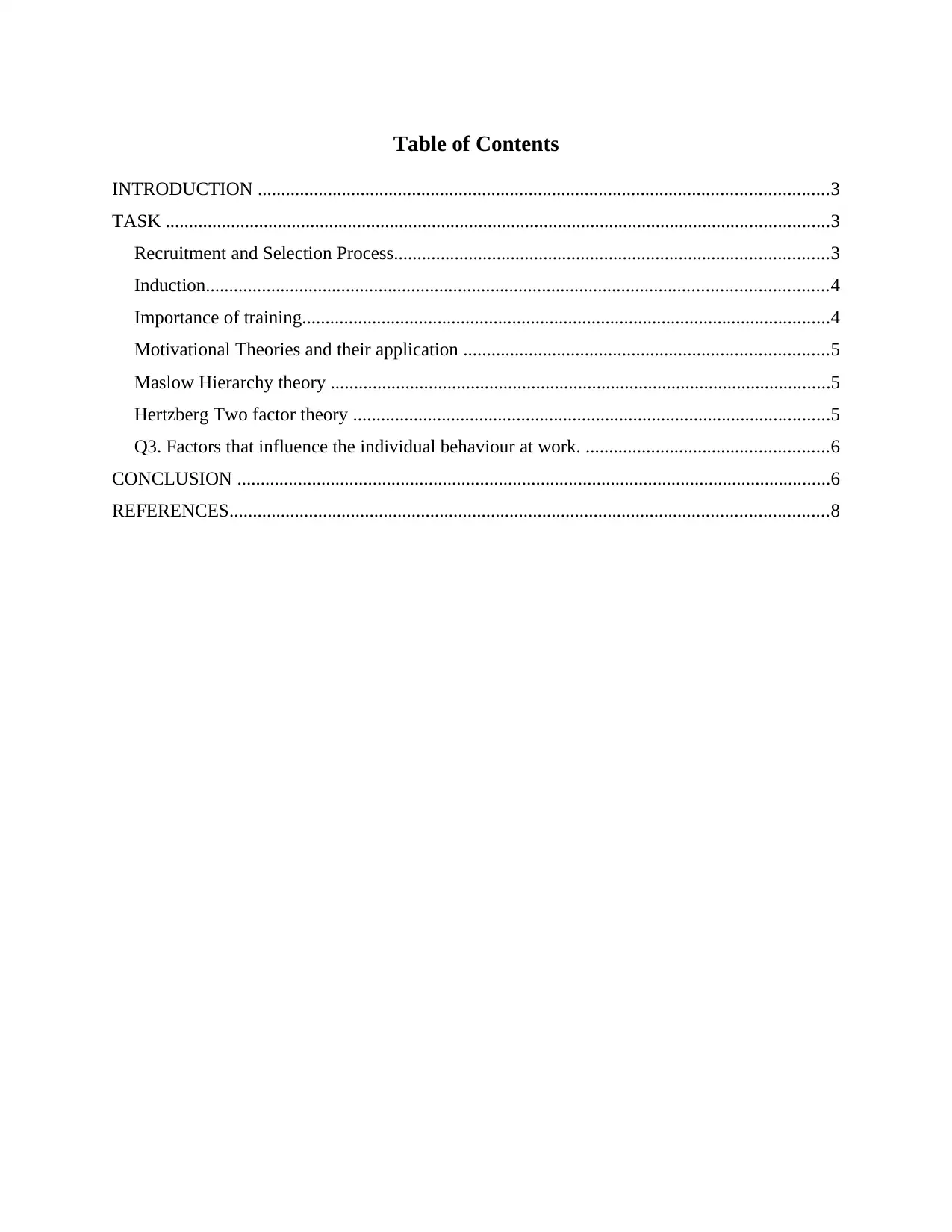
Table of Contents
INTRODUCTION ..........................................................................................................................3
TASK ..............................................................................................................................................3
Recruitment and Selection Process.............................................................................................3
Induction.....................................................................................................................................4
Importance of training.................................................................................................................4
Motivational Theories and their application ..............................................................................5
Maslow Hierarchy theory ...........................................................................................................5
Hertzberg Two factor theory ......................................................................................................5
Q3. Factors that influence the individual behaviour at work. ....................................................6
CONCLUSION ...............................................................................................................................6
REFERENCES................................................................................................................................8
INTRODUCTION ..........................................................................................................................3
TASK ..............................................................................................................................................3
Recruitment and Selection Process.............................................................................................3
Induction.....................................................................................................................................4
Importance of training.................................................................................................................4
Motivational Theories and their application ..............................................................................5
Maslow Hierarchy theory ...........................................................................................................5
Hertzberg Two factor theory ......................................................................................................5
Q3. Factors that influence the individual behaviour at work. ....................................................6
CONCLUSION ...............................................................................................................................6
REFERENCES................................................................................................................................8
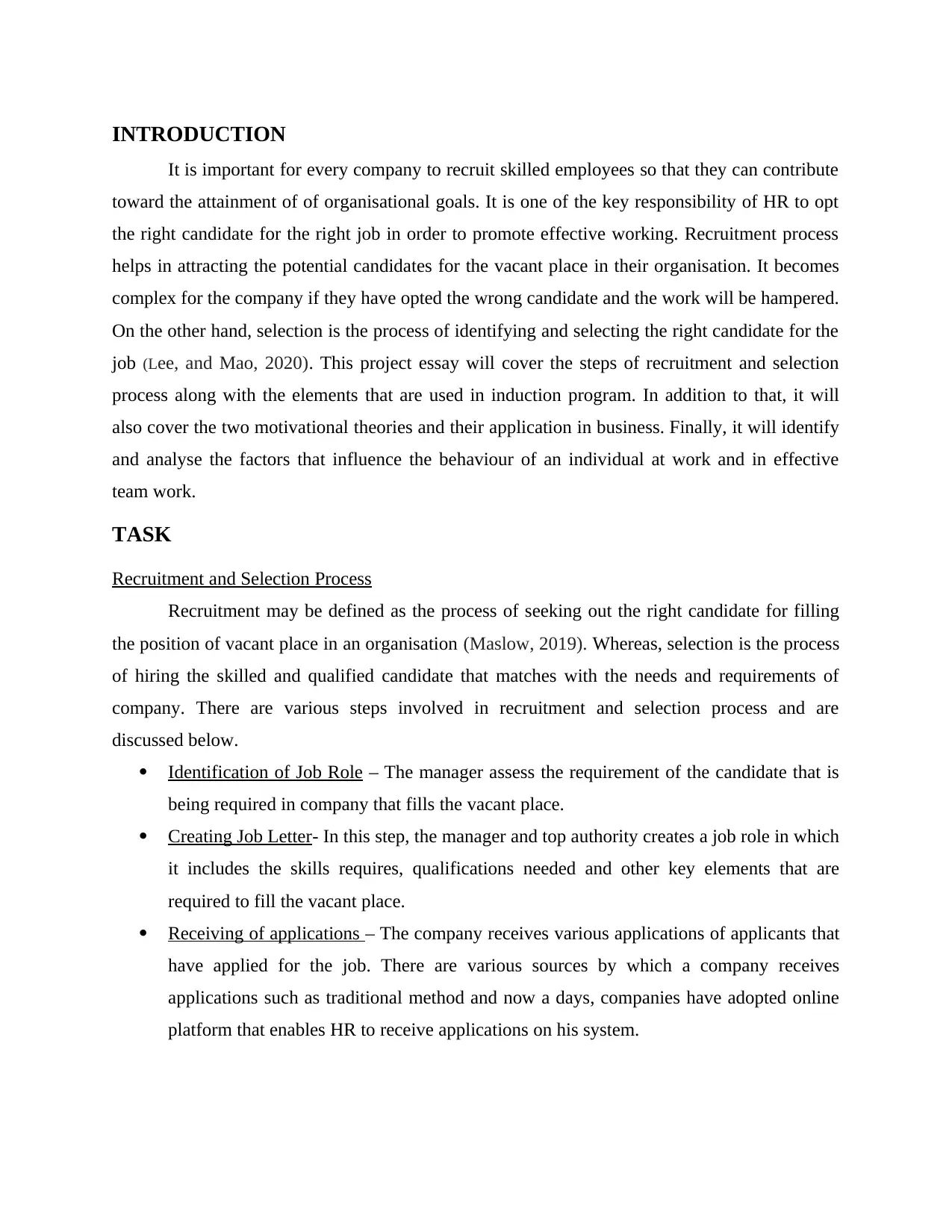
INTRODUCTION
It is important for every company to recruit skilled employees so that they can contribute
toward the attainment of of organisational goals. It is one of the key responsibility of HR to opt
the right candidate for the right job in order to promote effective working. Recruitment process
helps in attracting the potential candidates for the vacant place in their organisation. It becomes
complex for the company if they have opted the wrong candidate and the work will be hampered.
On the other hand, selection is the process of identifying and selecting the right candidate for the
job (Lee, and Mao, 2020). This project essay will cover the steps of recruitment and selection
process along with the elements that are used in induction program. In addition to that, it will
also cover the two motivational theories and their application in business. Finally, it will identify
and analyse the factors that influence the behaviour of an individual at work and in effective
team work.
TASK
Recruitment and Selection Process
Recruitment may be defined as the process of seeking out the right candidate for filling
the position of vacant place in an organisation (Maslow, 2019). Whereas, selection is the process
of hiring the skilled and qualified candidate that matches with the needs and requirements of
company. There are various steps involved in recruitment and selection process and are
discussed below.
Identification of Job Role – The manager assess the requirement of the candidate that is
being required in company that fills the vacant place.
Creating Job Letter- In this step, the manager and top authority creates a job role in which
it includes the skills requires, qualifications needed and other key elements that are
required to fill the vacant place.
Receiving of applications – The company receives various applications of applicants that
have applied for the job. There are various sources by which a company receives
applications such as traditional method and now a days, companies have adopted online
platform that enables HR to receive applications on his system.
It is important for every company to recruit skilled employees so that they can contribute
toward the attainment of of organisational goals. It is one of the key responsibility of HR to opt
the right candidate for the right job in order to promote effective working. Recruitment process
helps in attracting the potential candidates for the vacant place in their organisation. It becomes
complex for the company if they have opted the wrong candidate and the work will be hampered.
On the other hand, selection is the process of identifying and selecting the right candidate for the
job (Lee, and Mao, 2020). This project essay will cover the steps of recruitment and selection
process along with the elements that are used in induction program. In addition to that, it will
also cover the two motivational theories and their application in business. Finally, it will identify
and analyse the factors that influence the behaviour of an individual at work and in effective
team work.
TASK
Recruitment and Selection Process
Recruitment may be defined as the process of seeking out the right candidate for filling
the position of vacant place in an organisation (Maslow, 2019). Whereas, selection is the process
of hiring the skilled and qualified candidate that matches with the needs and requirements of
company. There are various steps involved in recruitment and selection process and are
discussed below.
Identification of Job Role – The manager assess the requirement of the candidate that is
being required in company that fills the vacant place.
Creating Job Letter- In this step, the manager and top authority creates a job role in which
it includes the skills requires, qualifications needed and other key elements that are
required to fill the vacant place.
Receiving of applications – The company receives various applications of applicants that
have applied for the job. There are various sources by which a company receives
applications such as traditional method and now a days, companies have adopted online
platform that enables HR to receive applications on his system.
⊘ This is a preview!⊘
Do you want full access?
Subscribe today to unlock all pages.

Trusted by 1+ million students worldwide
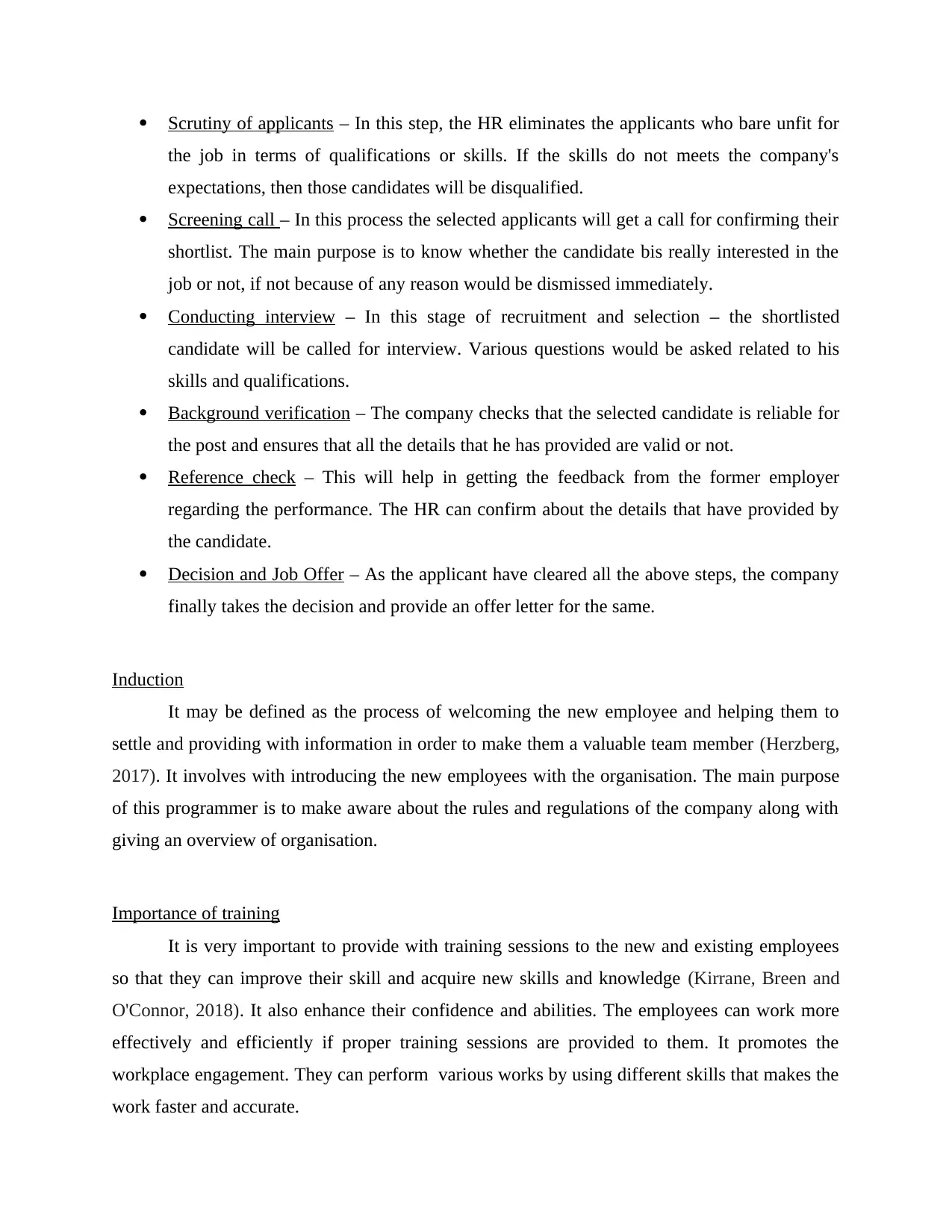
Scrutiny of applicants – In this step, the HR eliminates the applicants who bare unfit for
the job in terms of qualifications or skills. If the skills do not meets the company's
expectations, then those candidates will be disqualified.
Screening call – In this process the selected applicants will get a call for confirming their
shortlist. The main purpose is to know whether the candidate bis really interested in the
job or not, if not because of any reason would be dismissed immediately.
Conducting interview – In this stage of recruitment and selection – the shortlisted
candidate will be called for interview. Various questions would be asked related to his
skills and qualifications.
Background verification – The company checks that the selected candidate is reliable for
the post and ensures that all the details that he has provided are valid or not.
Reference check – This will help in getting the feedback from the former employer
regarding the performance. The HR can confirm about the details that have provided by
the candidate.
Decision and Job Offer – As the applicant have cleared all the above steps, the company
finally takes the decision and provide an offer letter for the same.
Induction
It may be defined as the process of welcoming the new employee and helping them to
settle and providing with information in order to make them a valuable team member (Herzberg,
2017). It involves with introducing the new employees with the organisation. The main purpose
of this programmer is to make aware about the rules and regulations of the company along with
giving an overview of organisation.
Importance of training
It is very important to provide with training sessions to the new and existing employees
so that they can improve their skill and acquire new skills and knowledge (Kirrane, Breen and
O'Connor, 2018). It also enhance their confidence and abilities. The employees can work more
effectively and efficiently if proper training sessions are provided to them. It promotes the
workplace engagement. They can perform various works by using different skills that makes the
work faster and accurate.
the job in terms of qualifications or skills. If the skills do not meets the company's
expectations, then those candidates will be disqualified.
Screening call – In this process the selected applicants will get a call for confirming their
shortlist. The main purpose is to know whether the candidate bis really interested in the
job or not, if not because of any reason would be dismissed immediately.
Conducting interview – In this stage of recruitment and selection – the shortlisted
candidate will be called for interview. Various questions would be asked related to his
skills and qualifications.
Background verification – The company checks that the selected candidate is reliable for
the post and ensures that all the details that he has provided are valid or not.
Reference check – This will help in getting the feedback from the former employer
regarding the performance. The HR can confirm about the details that have provided by
the candidate.
Decision and Job Offer – As the applicant have cleared all the above steps, the company
finally takes the decision and provide an offer letter for the same.
Induction
It may be defined as the process of welcoming the new employee and helping them to
settle and providing with information in order to make them a valuable team member (Herzberg,
2017). It involves with introducing the new employees with the organisation. The main purpose
of this programmer is to make aware about the rules and regulations of the company along with
giving an overview of organisation.
Importance of training
It is very important to provide with training sessions to the new and existing employees
so that they can improve their skill and acquire new skills and knowledge (Kirrane, Breen and
O'Connor, 2018). It also enhance their confidence and abilities. The employees can work more
effectively and efficiently if proper training sessions are provided to them. It promotes the
workplace engagement. They can perform various works by using different skills that makes the
work faster and accurate.
Paraphrase This Document
Need a fresh take? Get an instant paraphrase of this document with our AI Paraphraser
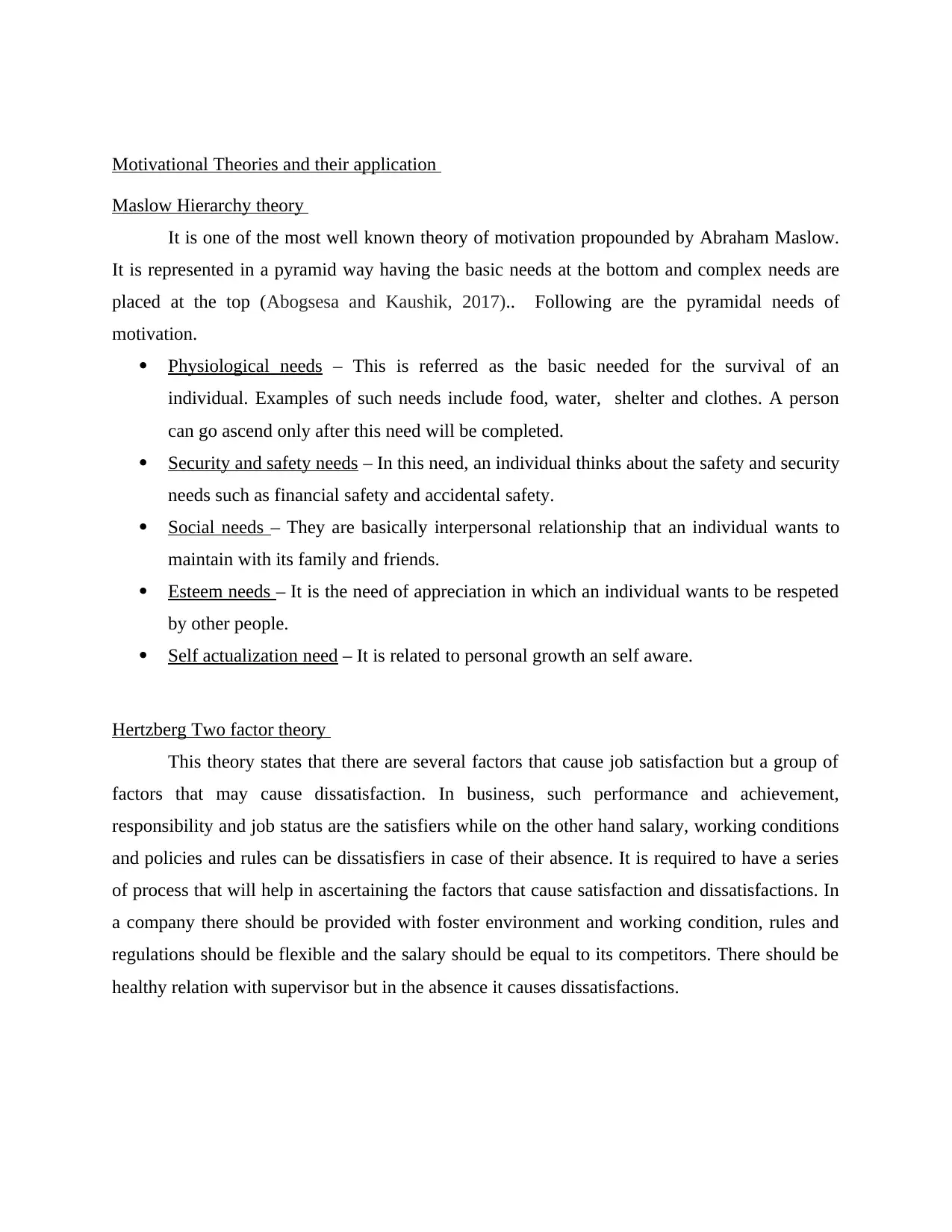
Motivational Theories and their application
Maslow Hierarchy theory
It is one of the most well known theory of motivation propounded by Abraham Maslow.
It is represented in a pyramid way having the basic needs at the bottom and complex needs are
placed at the top (Abogsesa and Kaushik, 2017).. Following are the pyramidal needs of
motivation.
Physiological needs – This is referred as the basic needed for the survival of an
individual. Examples of such needs include food, water, shelter and clothes. A person
can go ascend only after this need will be completed.
Security and safety needs – In this need, an individual thinks about the safety and security
needs such as financial safety and accidental safety.
Social needs – They are basically interpersonal relationship that an individual wants to
maintain with its family and friends.
Esteem needs – It is the need of appreciation in which an individual wants to be respeted
by other people.
Self actualization need – It is related to personal growth an self aware.
Hertzberg Two factor theory
This theory states that there are several factors that cause job satisfaction but a group of
factors that may cause dissatisfaction. In business, such performance and achievement,
responsibility and job status are the satisfiers while on the other hand salary, working conditions
and policies and rules can be dissatisfiers in case of their absence. It is required to have a series
of process that will help in ascertaining the factors that cause satisfaction and dissatisfactions. In
a company there should be provided with foster environment and working condition, rules and
regulations should be flexible and the salary should be equal to its competitors. There should be
healthy relation with supervisor but in the absence it causes dissatisfactions.
Maslow Hierarchy theory
It is one of the most well known theory of motivation propounded by Abraham Maslow.
It is represented in a pyramid way having the basic needs at the bottom and complex needs are
placed at the top (Abogsesa and Kaushik, 2017).. Following are the pyramidal needs of
motivation.
Physiological needs – This is referred as the basic needed for the survival of an
individual. Examples of such needs include food, water, shelter and clothes. A person
can go ascend only after this need will be completed.
Security and safety needs – In this need, an individual thinks about the safety and security
needs such as financial safety and accidental safety.
Social needs – They are basically interpersonal relationship that an individual wants to
maintain with its family and friends.
Esteem needs – It is the need of appreciation in which an individual wants to be respeted
by other people.
Self actualization need – It is related to personal growth an self aware.
Hertzberg Two factor theory
This theory states that there are several factors that cause job satisfaction but a group of
factors that may cause dissatisfaction. In business, such performance and achievement,
responsibility and job status are the satisfiers while on the other hand salary, working conditions
and policies and rules can be dissatisfiers in case of their absence. It is required to have a series
of process that will help in ascertaining the factors that cause satisfaction and dissatisfactions. In
a company there should be provided with foster environment and working condition, rules and
regulations should be flexible and the salary should be equal to its competitors. There should be
healthy relation with supervisor but in the absence it causes dissatisfactions.
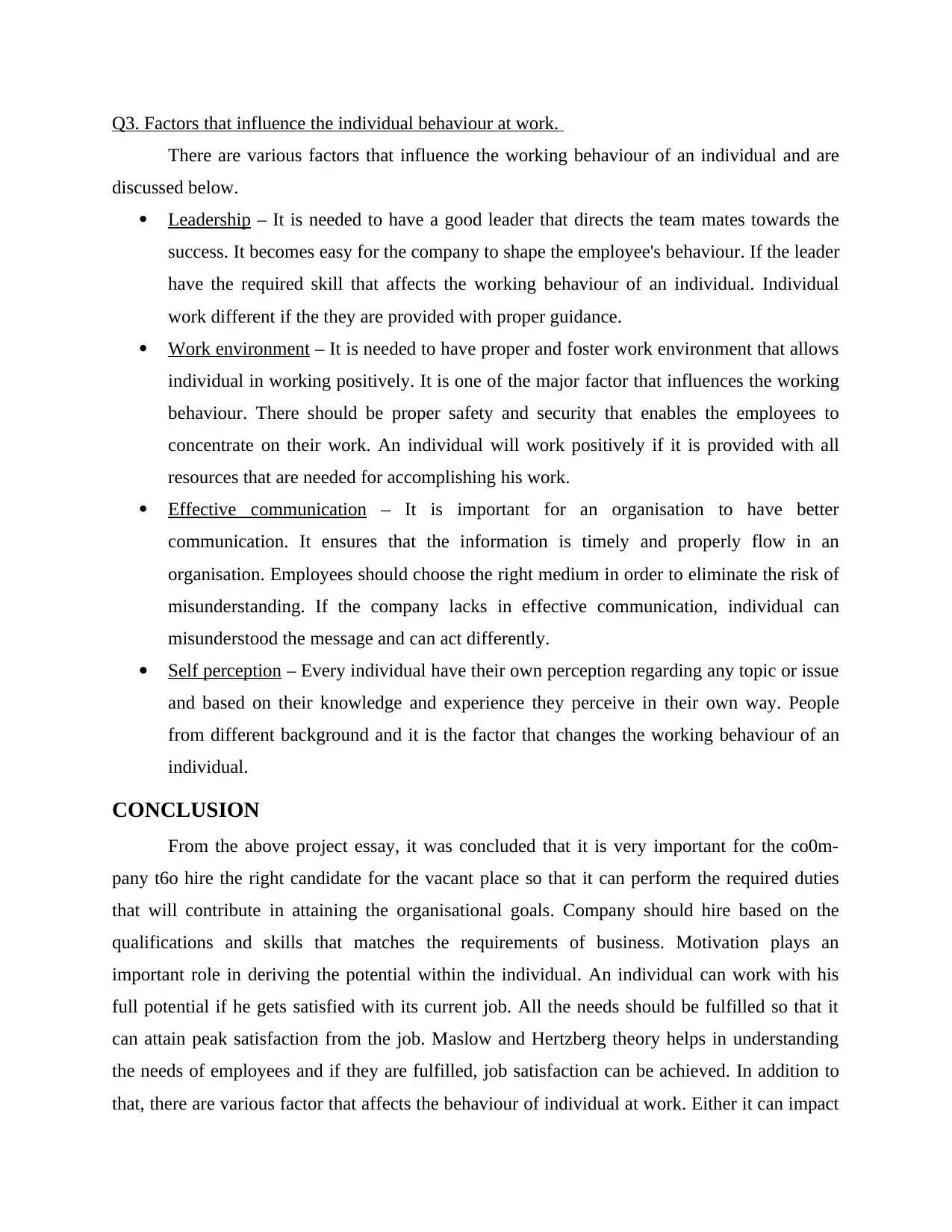
Q3. Factors that influence the individual behaviour at work.
There are various factors that influence the working behaviour of an individual and are
discussed below.
Leadership – It is needed to have a good leader that directs the team mates towards the
success. It becomes easy for the company to shape the employee's behaviour. If the leader
have the required skill that affects the working behaviour of an individual. Individual
work different if the they are provided with proper guidance.
Work environment – It is needed to have proper and foster work environment that allows
individual in working positively. It is one of the major factor that influences the working
behaviour. There should be proper safety and security that enables the employees to
concentrate on their work. An individual will work positively if it is provided with all
resources that are needed for accomplishing his work.
Effective communication – It is important for an organisation to have better
communication. It ensures that the information is timely and properly flow in an
organisation. Employees should choose the right medium in order to eliminate the risk of
misunderstanding. If the company lacks in effective communication, individual can
misunderstood the message and can act differently.
Self perception – Every individual have their own perception regarding any topic or issue
and based on their knowledge and experience they perceive in their own way. People
from different background and it is the factor that changes the working behaviour of an
individual.
CONCLUSION
From the above project essay, it was concluded that it is very important for the co0m-
pany t6o hire the right candidate for the vacant place so that it can perform the required duties
that will contribute in attaining the organisational goals. Company should hire based on the
qualifications and skills that matches the requirements of business. Motivation plays an
important role in deriving the potential within the individual. An individual can work with his
full potential if he gets satisfied with its current job. All the needs should be fulfilled so that it
can attain peak satisfaction from the job. Maslow and Hertzberg theory helps in understanding
the needs of employees and if they are fulfilled, job satisfaction can be achieved. In addition to
that, there are various factor that affects the behaviour of individual at work. Either it can impact
There are various factors that influence the working behaviour of an individual and are
discussed below.
Leadership – It is needed to have a good leader that directs the team mates towards the
success. It becomes easy for the company to shape the employee's behaviour. If the leader
have the required skill that affects the working behaviour of an individual. Individual
work different if the they are provided with proper guidance.
Work environment – It is needed to have proper and foster work environment that allows
individual in working positively. It is one of the major factor that influences the working
behaviour. There should be proper safety and security that enables the employees to
concentrate on their work. An individual will work positively if it is provided with all
resources that are needed for accomplishing his work.
Effective communication – It is important for an organisation to have better
communication. It ensures that the information is timely and properly flow in an
organisation. Employees should choose the right medium in order to eliminate the risk of
misunderstanding. If the company lacks in effective communication, individual can
misunderstood the message and can act differently.
Self perception – Every individual have their own perception regarding any topic or issue
and based on their knowledge and experience they perceive in their own way. People
from different background and it is the factor that changes the working behaviour of an
individual.
CONCLUSION
From the above project essay, it was concluded that it is very important for the co0m-
pany t6o hire the right candidate for the vacant place so that it can perform the required duties
that will contribute in attaining the organisational goals. Company should hire based on the
qualifications and skills that matches the requirements of business. Motivation plays an
important role in deriving the potential within the individual. An individual can work with his
full potential if he gets satisfied with its current job. All the needs should be fulfilled so that it
can attain peak satisfaction from the job. Maslow and Hertzberg theory helps in understanding
the needs of employees and if they are fulfilled, job satisfaction can be achieved. In addition to
that, there are various factor that affects the behaviour of individual at work. Either it can impact
⊘ This is a preview!⊘
Do you want full access?
Subscribe today to unlock all pages.

Trusted by 1+ million students worldwide
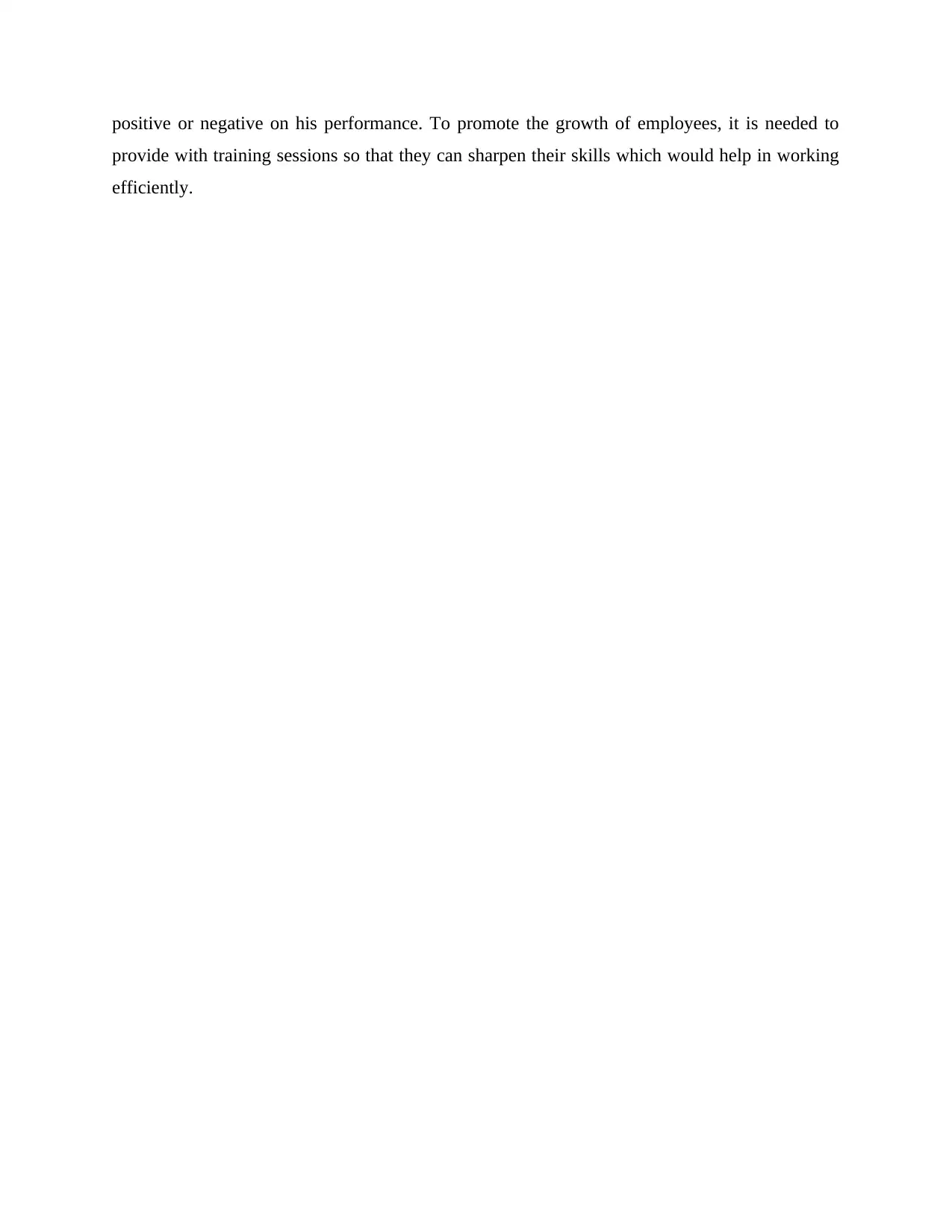
positive or negative on his performance. To promote the growth of employees, it is needed to
provide with training sessions so that they can sharpen their skills which would help in working
efficiently.
provide with training sessions so that they can sharpen their skills which would help in working
efficiently.
Paraphrase This Document
Need a fresh take? Get an instant paraphrase of this document with our AI Paraphraser
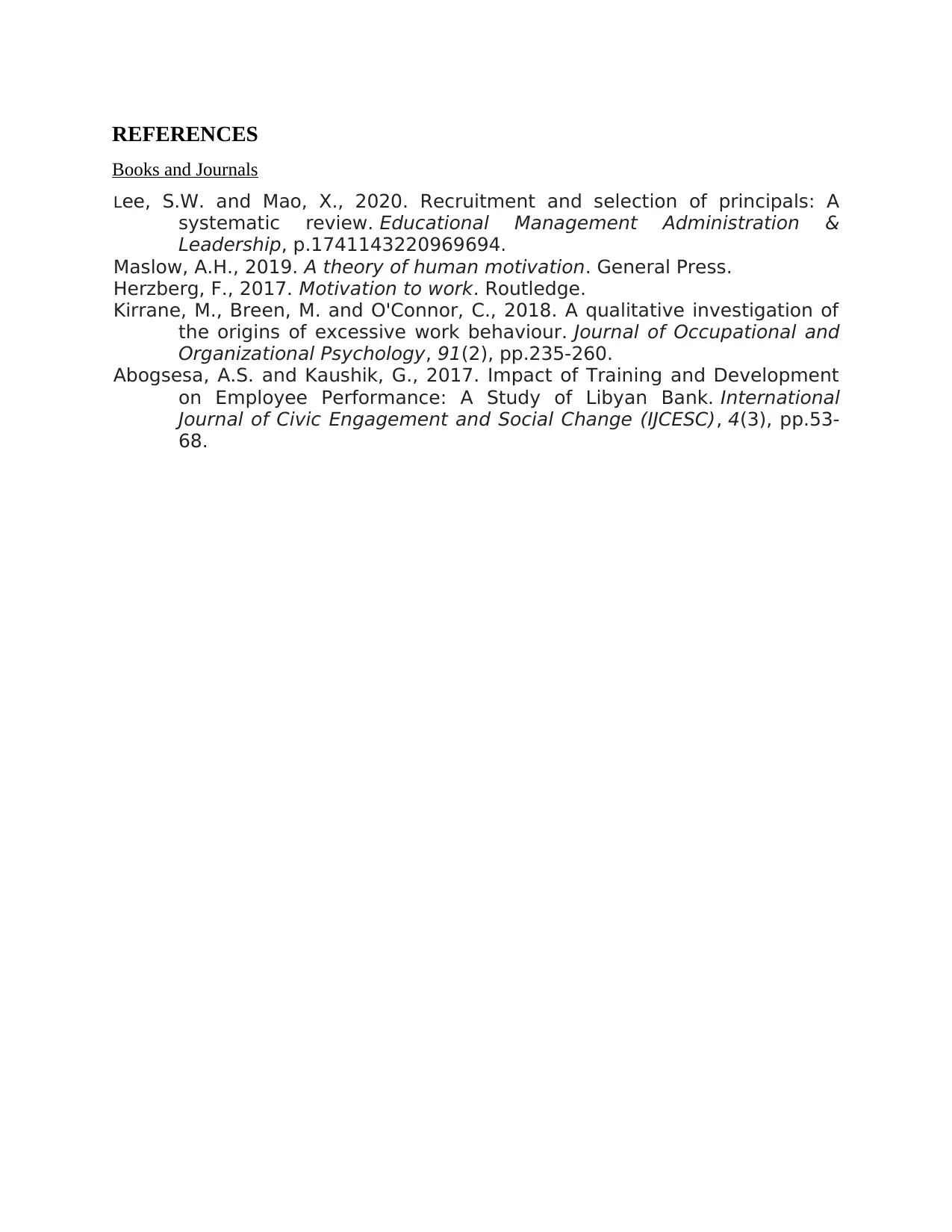
REFERENCES
Books and Journals
Lee, S.W. and Mao, X., 2020. Recruitment and selection of principals: A
systematic review. Educational Management Administration &
Leadership, p.1741143220969694.
Maslow, A.H., 2019. A theory of human motivation. General Press.
Herzberg, F., 2017. Motivation to work. Routledge.
Kirrane, M., Breen, M. and O'Connor, C., 2018. A qualitative investigation of
the origins of excessive work behaviour. Journal of Occupational and
Organizational Psychology, 91(2), pp.235-260.
Abogsesa, A.S. and Kaushik, G., 2017. Impact of Training and Development
on Employee Performance: A Study of Libyan Bank. International
Journal of Civic Engagement and Social Change (IJCESC), 4(3), pp.53-
68.
Books and Journals
Lee, S.W. and Mao, X., 2020. Recruitment and selection of principals: A
systematic review. Educational Management Administration &
Leadership, p.1741143220969694.
Maslow, A.H., 2019. A theory of human motivation. General Press.
Herzberg, F., 2017. Motivation to work. Routledge.
Kirrane, M., Breen, M. and O'Connor, C., 2018. A qualitative investigation of
the origins of excessive work behaviour. Journal of Occupational and
Organizational Psychology, 91(2), pp.235-260.
Abogsesa, A.S. and Kaushik, G., 2017. Impact of Training and Development
on Employee Performance: A Study of Libyan Bank. International
Journal of Civic Engagement and Social Change (IJCESC), 4(3), pp.53-
68.
1 out of 8
Related Documents
Your All-in-One AI-Powered Toolkit for Academic Success.
+13062052269
info@desklib.com
Available 24*7 on WhatsApp / Email
![[object Object]](/_next/static/media/star-bottom.7253800d.svg)
Unlock your academic potential
Copyright © 2020–2025 A2Z Services. All Rights Reserved. Developed and managed by ZUCOL.




